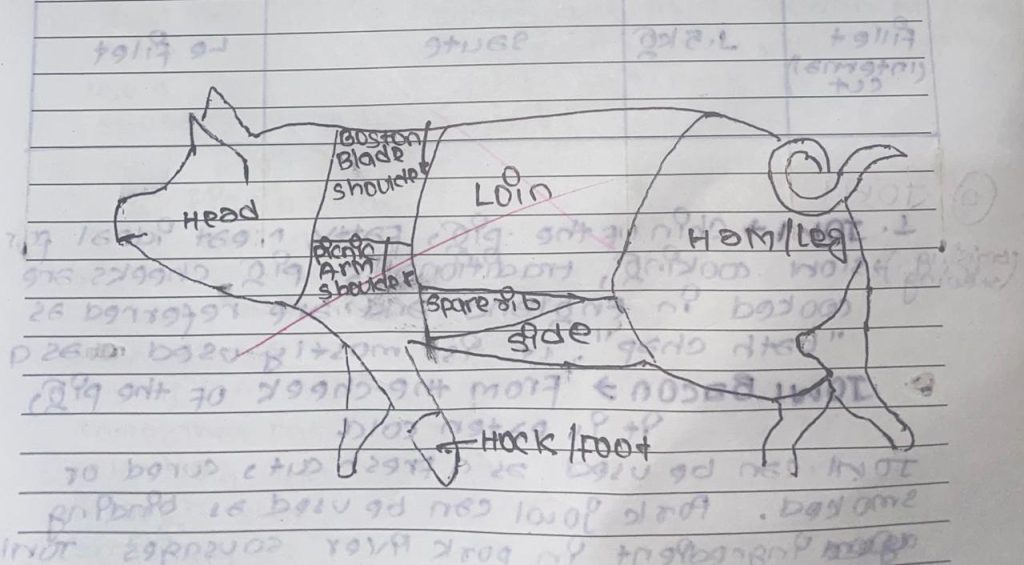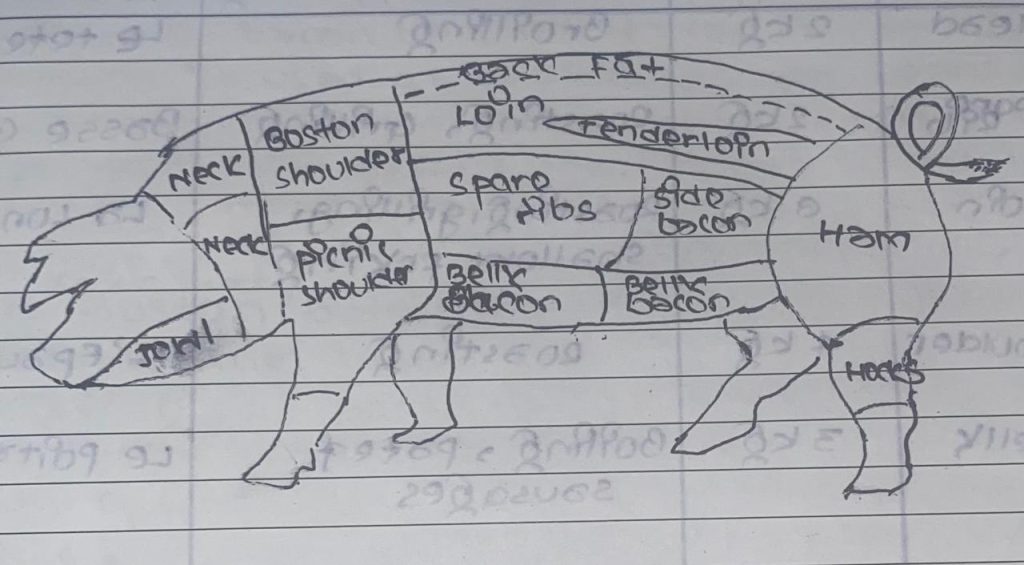Introduction to Pork
Pork is the meat obtained from domesticated pigs (Sus scrofa domesticus). It is one of the most widely consumed meats globally and is valued for its flavor, versatility, and fat content.
Pigs are omnivorous animals, and improper feeding—such as consumption of garbage or sewage—can make them carriers of disease-causing organisms, including parasites like tapeworms. Therefore, proper animal husbandry, hygiene, and regular health checks are essential to ensure pork is safe for human consumption.
Pork is consumed in various forms, including:
- Fresh/cooked: Roasted, grilled, or boiled
- Cured or salted: Smoked, salted, or preserved
- Processed products: Bacon, ham, sausages, and lard
Pork is generally classified as lean meat, though it typically contains more fat than other common meats like beef or lamb. Pork fat, commonly called lard, is widely used in cooking and baking.
Quality Points of Pork
When selecting or evaluating pork, the following quality characteristics should be considered:
- Flesh
- Should be moist, firm, and pale pink.
- Avoid meat that is dull, sticky, or excessively soft, as it may indicate poor handling or aging.
- Fat
- Should not be excessive, ensuring a balanced lean-to-fat ratio.
- Fat should be white and firm, not yellow, soft, or greasy, which may indicate old or poorly fed animals.
- Proper fat enhances flavor and cooking quality.
- Skin
- Should be smooth, hairless, and undamaged.
- Cuts, bruises, or rough skin may indicate improper slaughtering or handling.
- Odor
- Should have a pleasant, fresh smell typical of fresh meat.
- No signs of rancidity, sourness, or ammonia-like odors should be present, as these indicate spoilage or bacterial growth.
- Appearance and Handling Indicators
- Carcass should have even color and texture, without dark spots or discoloration.
- Properly handled pork should be clean, hygienic, and free from blood clots or abnormal fluids.
- Marbling
- Fine streaks of fat within the muscle (marbling) improve tenderness, juiciness, and flavor.
- Meat with very little marbling may be lean but can be less flavorful.
Nutritional Value of Pork
Pork is a rich source of protein and B-complex vitamins, especially thiamine (B1), which is higher in pork than in most other meats. Also, fat content varies by cut and breed; lean cuts (like tenderloin) have lower fat, while belly and shoulder cuts are higher.
Nutritional Value of Pork (per 100 g) contains:
- Energy: 242 kcal
- Protein: 27 g
- Total Fat: 14 g
- Saturated Fat: 5 g
- Cholesterol: 80 mg
- Carbohydrates: 0 g
- Vitamin B1 (Thiamine): 0.8 mg
- Vitamin B3 (Niacin): 5 mg
- Vitamin B6: 0.5 mg
- Vitamin B12: 0.7 µg
- Iron: 1 mg
- Zinc: 2.9 mg
- Phosphorus: 220 mg
- Selenium: 35 µg
Storage of Pork
Proper storage is essential to maintain pork quality, freshness, and safety.
- Fresh Pork
- Refrigeration: Keep at 0–4°C for up to 2–3 days.
- Freezing: Store at −18°C or below for 6–12 months (depending on cut and packaging).
- Packaging: Use airtight containers or vacuum-sealed packs to prevent oxidation and microbial growth.
- Cooked Pork Storage
- Refrigeration: Store cooked pork at 0–4°C for 3–4 days.
- Freezing: Cooked pork can be frozen at −18°C for 2–3 months.
- Cured and Processed Pork Storage
- Bacon, ham, sausages: Follow manufacturer instructions; generally refrigerated at 0–4°C.
- Proper storage prevents spoilage, rancidity, and bacterial contamination.
- Handling tips
- Avoid repeated thawing and refreezing, as it affects texture and quality.
- Keep pork separate from other foods to prevent cross-contamination.
- Always check for off-odors, discoloration, or slime before use.
Cuts of Pork

(Both figures are correct. The below figure is more detailed for better understanding. If question is asked from this topic in exam in 5 or 10 marks, make figure compulsorily)

- Jowl
The jowl is the chin or cheek of the pig. It is a fatty, flavorful cut that is ideal for slow cooking.- Traditional dishes: In England, pig cheeks are cooked and referred to as “Bath Chap”.
- Jowl bacon: The jowl can be cured and smoked to produce jowl bacon, often eaten cold.
- Fresh, cured, or smoked: Jowl can be used in all these forms depending on the recipe.
- Sausage: Pork jowl can act as a binding ingredient in pork liver sausages due to its fat content.
- Garnish: Chopped jowl can be used as a garnish, similar to bacon bits, or served in sandwiches.
- Flavoring: Often used to season beans, black-eyed peas, or leafy green vegetables, adding richness and flavor.
- Shoulder
The shoulder of pork is a versatile cut that comes from the upper portion of the hog. Overall, pork shoulder is a versatile cut suitable for a wide range of cooking methods, including roasting, braising, grilling, smoking, and slow cooking.
It is divided into two main sections:- Boston Butt / Blade Shoulder
The Boston Butt, also called Boston Shoulder or Blade Shoulder, comes from the upper shoulder, including parts of the neck, shoulder blade, and upper arm. It is a moderately tough cut with a good amount of connective tissue. This cut can be roasted, cut into steaks, braised, stewed, or used for making ground pork and sausages. - Picnic Shoulder
Located just below the Boston Butt, the Picnic Shoulder (also known as Picnic Ham, Arm Roast, or Arm Shoulder) is somewhat fatty and sinewy. It is often cured or used to produce ground pork or sausage meat. Due to its texture, it requires slow cooking methods like roasting or braising to become tender.
- Boston Butt / Blade Shoulder
- Loin
The pork loin is one of the leanest and most tender parts of the pig. It is best suited for dry heat cooking methods such as grilling, baking, or sautéing, though ribs from this section may also benefit from slow cooking.
The loin is commonly divided into four sections: Blade End, Rib Section, Loin Center, and Sirloin.- Blade End / Blade Chop: Located at the front end of the loin near the shoulder. This section has some connective tissue and is suitable for roasting.
- Rib Section / Rib Chops: Situated just behind the blade end, this section contains rib bones. Ribs can be grilled, roasted, or slow-cooked for tenderness.
- Loin Center / Loin Chop: The middle portion of the loin; very tender and lean. Ideal for grilling, baking, or pan-frying.
- Sirloin: The rear end of the loin, near the ham section. Fairly lean with some fat, making it suitable for grilling or pan-frying.
- Belly
The belly of the pig includes two important sub-cuts: spare ribs and pork side (pork belly). These are located on the underside of the carcass, below the loin, where the ribs meet the breastbone. The meat here is generally fattier, but extremely flavorful and versatile in cookery.- Spare Ribs
The spare ribs come from the belly side of the rib cage, near where the ribs connect to the breastbone. This cut includes the ribs along with the surrounding meat, giving it rich flavor and tenderness when cooked properly. - Pork side
The pork side—commonly known as pork belly—is the section located directly below the loin. This is the part from which bacon and pancetta are produced. Because of its higher fat content, it cooks beautifully and stays moist.
- Spare Ribs
- Head
The head of the pig provides several useful parts for cookery. It is often used to prepare brown stocks, rich soups, and gelatinous broths because of its high collagen content. When boiled, different components like the ears, cheeks, and jowls become tender and flavorful. - Leg (Ham)
The leg is the large hind portion of the pig and is one of the most valuable primal cuts. It contains firm, lean muscles with minimal connective tissue, making it suitable for a wide range of cooking methods. The leg is also the cut used for producing ham, one of the most popular cured pork products worldwide.
Uses:
a. Stocks and soups
b. Braising
c. Slow-cooked stews
d. Adds richness to beans, lentils, and hearty dishes
Characteristics:- Lean, firm, fine-textured meat
- Contains large muscles with little intramuscular fat
- Can be used fresh, cured, or smoked
- Excellent for both dry-heat and moist-heat cooking methods
- Hock
Pork hock, also called ham hock or pork knuckle, is the section between the leg (ham) and the pig’s foot. It has skin, bone, and connective tissue with very little lean meat. Tough raw, but becomes tender and gelatin-rich when slow-cooked.
Characteristics:
a. Tough cut with high collagen
b. Contains skin, bone, little meat
c. Very flavorful when cooked slowly
d. Often sold fresh, cured, or smoked
Uses:- Stocks and soups
- Braised dishes
- Stews and casseroles
- Flavoring beans, lentils, and greens
Introduction to Ham and Bacon.
Ham is the hind leg of the pig that has been preserved through curing methods such as salting, brining, smoking, or a combination of these. It can be sold fresh, cured, or fully cooked. Because curing enhances flavor and shelf life, ham is one of the oldest forms of processed meat.
Bacon is made from the pork belly (side) or sometimes from back cuts of the pig. The meat is salt-cured, often smoked, and then thinly sliced. It has a rich, savory flavor with a crisp texture when cooked.
Methods of Salting (Curing)
Salt curing is the oldest and most essential method of preserving ham. It can be applied in two main ways:
- Brine Solution (Wet Cure)
- Meat is soaked in a salt and water solution (brine).
- Sometimes sugar, spices, and nitrates are added.
- Faster penetration and more uniform curing.
- Dry Cure
- Meat is completely covered with dry salt.
- Must be kept for at least 4 weeks for proper penetration.
- Produces a firmer texture and stronger flavor.
Differences Between Ham and Bacon
| Basis | Ham | Bacon |
|---|---|---|
| Source | Hind leg (ham) of the pig | Pork belly or jowl (side of the pig) |
| Fat content | Leaner, less fat | Higher fat content |
| Curing Methods | Usually wet-cured (brine) or dry-cured | Usually dry-cured or smoked, sometimes brined |
| Taste and Texture | Mild, firm | Rich, fatty, flavorful |
| Cooking / Consumption | Often cooked, baked, or boiled before serving | Can be fried, grilled, or eaten cold (if smoked/cured) |
Pork Based Products
- Bacon
- Ham
- Sausages (fresh, cooked, smoked)
- Pork liver sausage / pâté / terrines
- Lard
- Head cheese / brawn
- Pork cracklings / chicharrón
- Smoked or cured pork products (e.g., pancetta, gammon)
- Pork preserves / confit
- Processed ready-to-eat pork items (deli meats
